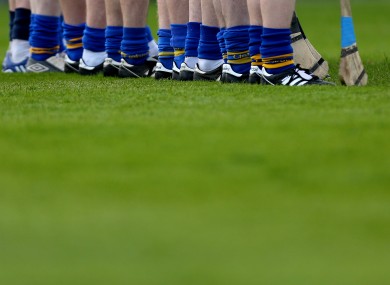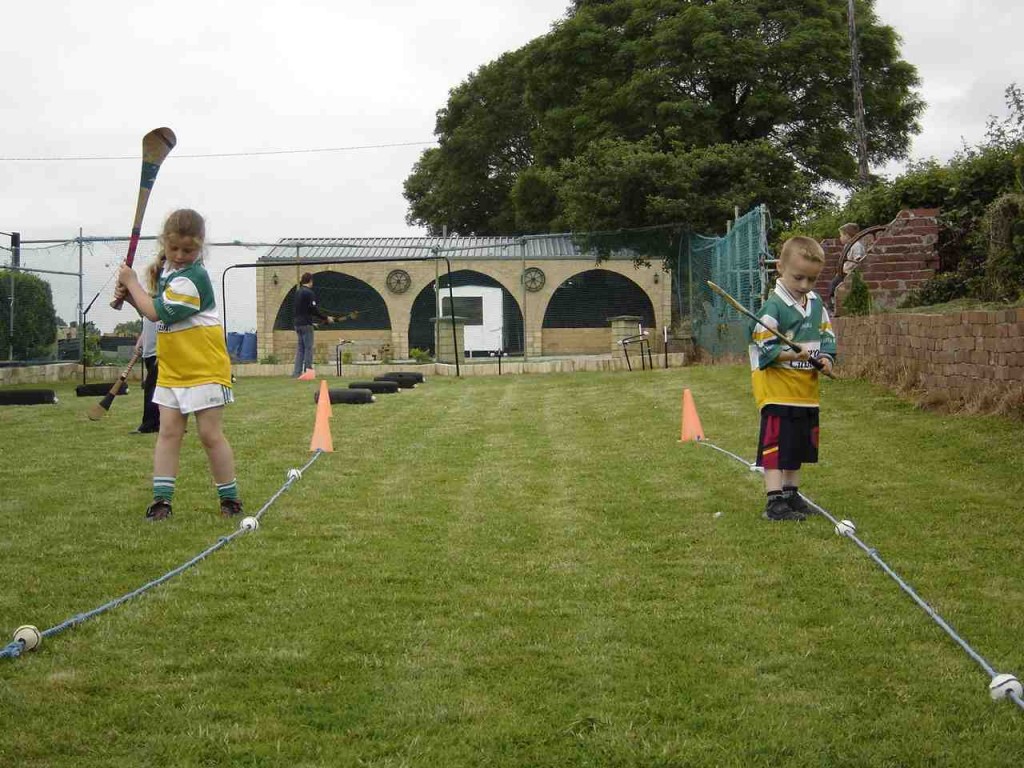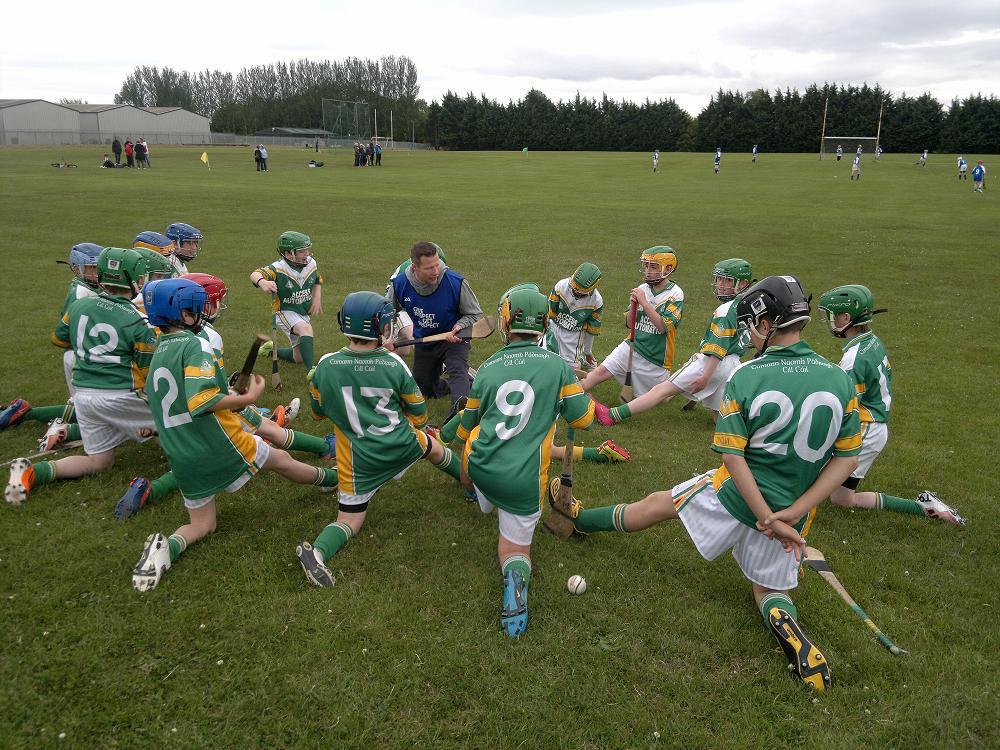Introduction and development of coaching
Coaching the basics @ u6
What basic skills will we coach @ u6?
Movement- how?
Through playing running, jumping, throwing, catching games that develop the flexibility and motor skills required to play our games
The hurl in the young players hands- how?
- Ask the player or his parent which hand is his dominant hand (the hand he uses most for holding a pencil or the hand he leads with)
- Demonstrate the key sections of the hurl- Bas, Toe, Heel, Shaft & Butt
- Demonstrate and then consistently coach the correct Lock and Grip position
- Demonstrate and then consistently coach the Ready Grip position
- Demonstrate and then consistently coach the correct hands/ hurl position for jab and roll lift.
- Demonstrate and then consistently coach the dominant side swing
- Demonstrate and then consistently coach the ground stroke
- Demonstrate and then consistently coach blocking and hooking of ground strokes
- Demonstrate and then consistently coach the basics of tackling when the ball is on the ground.
- Demonstrate and then consistently coach the clash ball, controlling the ball on the ground when dribbling.
How is the coach doing this?
- He has a small group of players
- He has the right equipment ( age appropriate sliotars, cones, rope sliotars, small hurdles, rope ladders)
- He is coaching the correct body position for each skill
- He is demonstrating the skill first and then he is observing and gently correcting and positively reinforcing the correct execution of the skill
- He is enthusiastic, using appropriate language and repeating the key words associated with each skill
- He is playing Go Games and Conditioned Games to coach the basics of positional awareness and to demonstrate the practical execution of the basic skills in a game situation
@ u6, the player will
- Begin to develop endurance through activities and games aimed at improving movement, agility and flexibility
- Develop wrist strength through correct striking activities such as ground striking, stationary and moving, rope sliotar activities, squeeze ball games, etc
- Begin to develop balance through activities including rope ladders, small hurdles, cup and saucer with cones, skipping, hopping and wheelbarrow
- Develop hand/ eye co-ordination through throw & catch activities and games, players in pairs throwing the ball to each other, under arm, over arm and overhead and players throwing the ball against the wall and catching it in the less dominant hand
- Develop lateral and multi directional movement and sprinting skills through activities and fun games (games like here, there and everywhere using coloured cones, traffic lights or other similar rapid movement games where players are required to change direction, stop, go backwards, crab movements)
- Begin to develop arm/ upper body strength and co-ordination through bunny hops, fun tug of war games
- Begin to become used to and skilled in close contact tacking and striking through clash ball activities
- Begin to get used to restricted space through limiting the area games and activities take place in
- Have fun and enjoy their games
- Begin to gain and demonstrate confidence in executing the skills they are learning
- Begin to visualise themselves executing the skills in a game situation
- Begin to understand the basic safety requirements of playing our games- helmets, gum shields, shin guards
- Begin to learn about fair play, respect for team mates, coaches, other players
- To develop an awareness about teamwork and being part of a team and a club
@u8 our players will have been coached in and will have developed skills in the basics of hurling @u6.
What is the coach trying to achieve @u8?
- He is coaching to add more technical and movement skills
- He is designing training to focus on individual player development and team and game play development
- He is aware of the physical and mental age appropriate requirements of his players
- He is planning his sessions to that each section of the session is focussed on distinct skills, is time defined, has a clear learning outcome or outcomes and is framed in a manner that is easily demonstrated and easily understood.
- He is coaching his players to maintain and develop the basic skills and then to perform and execute them in unopposed and opposed situations and to increase the speed and intensity of the execution of each skill.
- He is working with his players so that they gain confidence from executing the skills and them performing them in game play situations.
- He is operating from the principles of Go Games
What might an u8 training session look like?
- Each player has the correct equipment , a hurl and a helmet and boots
- For every 8 players, there is one coach
- Each coach has the necessary equipment to deliver his section of the training- sliotars, cones, bibs, poles, whistle, hurdles, ropes, ladders, etc
- The session is planned for 60 minutes
- Before the session, the manager/co-ordinator meets with his other coaches and sets out the learning outcome or outcomes they wish to achieve
- As players arrive a coach should greet them, ask how they are and divide them in pairs to strike off the dominant side at distances varying between 5 and 15 yards.
- Once all players confirmed to be there are ready, each coach should then begin his element of the session.
- Individual elements of each session should not last longer than 10 minutes once the coach demonstrates and explains the content of the session.
Part 1:
Hand Pass- players in pairs- 2 yards apart – holding hurl in dominant hand, they hand pass the sliotar to team mate opposite – execution is for crisp hand pass directed to other players chest- outcome is all players are executing the skill on a consistent basis- speed of the skill comes later in player’s development
Introduce movement – repeat the drill and players start moving in and out while executing the hand pass, the aim is to add competency and aid hand / eye co-ordination, speed comes later- the overall outcome of this drill is that u8 players are developing the basic mastery of the skill. One coach should demonstrate the skill and other coaches should observe, correct and positively reinforce the execution of it
Part 2
Jab Lift / Roll Lift – players in groups of 4 (2 in each group) – 10 yards apart. 1 sliotar is placed between the pairs. Coach demonstrates the drill and explains the key skills required – correct grip (remember this was coached @u6) knees used to bring back down low, hurl is parallel to the ground, one inch between hurl and surface, sliotar is jabbed into hand by sliding the hurl under the sliotar and ball in the player’s hand and under his control below his knee…. the jab lift is effective when the player has control of the sliotar before he straightens up to move forward. No more than 4 players so that each player gets plenty of time practising the skill- the objective here is the learning of the skill- executing it at speed comes later in the player’s development
Key skills to be learned and executed- grip, body agility and flexibility- positions- getting down over the ball- getting the ball under control before the players straightens up with ball in hand
Part 3:
Striking from hand- to aid consistent coaching, players should be coached to strike from the hand through
Þ The coaching of the correct stance
Þ The coaching of the correct grip
Þ The coaching of striking with correct swing and through the wrists
Þ The learn the skill, striking from the hand should first be in a ‘free’ environment where the player is encouraged to practice the skill by having one coach for every 4 players throw or lob the ball to the player to strike the ball in motion so that the swing and use of wrists is developed first – children will react positively to being allowed numerous attempts to learn this skill and as a general guide , each player should get 50 strikes in a 10 minute session. Once the skill is learned, players should strike from the hand at targets such as cones or skittles so that they can see the improvement Positive reinforcement and demonstration of the skill are crucial in this.
Þ As the season progresses, training sessions should then include the players striking from the hand off their dominant side so as to gain confidence in executing the skill.
Þ Coaches should include attempts to strike off the less dominant side once players have gained a basic control off the dominant side.
Þ As the players develop this skill, control of the moving sliotar should be introduced as part of striking from the hand
Þ The key to first touch control is (a) the position of the body- the player is to be coached to get his body behind the ball, feet apart and level with shoulders and (b) the grip and position of the hands on the hurl- the dominant hand to be a few inches down the shaft and the less dominant hand to be below the dominant hand –
Þ To aid this skill, coaches should roll the ball to each player (players to be in small groups) emphasising the position of the body and the grip /placement of hands on the hurl – as the player develops the skill, the coach should increase the speed the ball is being played at and as further development takes place, players in pairs should roll and then moving to strike the ball to each other.
Part 4:
Hooking and blocking- players at this grade should be introduced to the skills of hooking and blocking correctly – coaches should demonstrate the core elements of hooking and blocking – at first from a static standpoint and then through slow movement- the focus here must be on the player learning that these skills are core hurling skills and that to execute them correctly, body positioning, timing are critical elements.
Conditioned games: The core underlying principle of coaching at this age group is that each player spends as much time as possible with a ball in his hand so that he develops the core skills. Conditioned or modified games are methods to get players to demonstrate the skills they are learning in an environment where mistakes are corrected through positive reinforcement and players are encouraged to make decisions. There are dozens of methods of playing conditioned games but coaches should plan them so that the training and coaching element of each session are practiced and executed them.
The above outline is intended to show examples of the content of sessions that are age and skill level appropriate for young players.
Benchmarking @u8
Every coach should set out the learning outcomes he wants his players to have achieved before the leave the grade.
- Can the player strike comfortably off the ground on his dominant side?
- Can the player strike comfortably or have begun to strike off the ground on his less dominant side?
- Can the player strike from his hand?
- Can the player jab lift?
- Can the player roll lift?
- Can the player execute the hand pass?
- Does the player understand the basic principles and mechanics of hooking and blocking?
Coaching @u10 &u12
What should the coach be coaching @ u10?
|
The player has now, in most cases, experienced quality and focussed coaching for 2-3 years. He has developed core skills around v The correct grip v The correct stance v Jab/ roll lift v Basic hand pass v Basic understanding of hooking and blocking v The player has developed flexibility and agility and lateral and multilateral movement v The player has become familiar with structure and the role of the coach v The player has begun to play Go Games against other teams v The next steps for these players and their coaches is to aim for all training to be done at age appropriate speed and intensity |
Raising the Intensity
The coach/ coaches now have a group of players who enjoy playing the game. The next level of coaching is to introduce additional core skills and movement in all elements.
Basic hurling drills such as jab /roll lifts, hand passing, striking from the hand, hooking and blocking should be continued but at speed.
Coaches should introduce on a consistent basic drills that support the development of skills and mastery of
- Striking while running
- Jab and roll lift at pace with correct body positioning
- Striking off both sides
- Decision making and tactical understanding
- Batting down the sliotar and positioning and reaction to the breaking ball
- Diagonal striking to on-running team mates
- Hooking and blocking while moving
- Basic Warm Ups and Warm Downs
- Hydration and Nutrition
- Catching high ball
- Catching ball in the hand
- Keep the fun element by designing sessions that have sprint and movement in them
Ratio of Training to Games:
Ideally, a player should train 3 times between each game. The 3:1 ratio allows for players and coaches to reflect on a previous game, focus on the areas identified and implement these improvements in the next game. While it is not always possible to follow the ratio, training between games is the best way for players to learn and improve.





